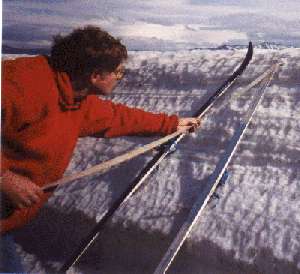"Ok, what about skins?"
Beginners don't normally need to put skins on the bottom of their skis. Because skins take time to put on and remove, they are most useful if you plan to go up hill for a half hour or more. If your climbing all day over a major pass, they're wonderful.
They can also be used to prevent falls going up or downhill on "Sierra Cement" - that is, when the snow is like slippery concrete. This occurs when snow is rained upon and then freezes.
 Skins are long strips of stuff which are affixed to the base of the skis to aid climbing steep hills. They are usually made of nylon or polypropylene (or mohair, if you're rich) with directional "fur" that allows the ski to slide forward but not backward. The ski-side is coated with an adhesive (some brands come pre-coated, others don't) which sticks to the base of the ski, which should be fairly clean and dry and free of sticky wax. The tip of the skin has a loop which goes over the ski tip; usually there is no attachment at the tail, just the glue, but you can buy "tail-fix" kits which provide a hook for the back end of the skin. (Duct tape works too.)
Skins are long strips of stuff which are affixed to the base of the skis to aid climbing steep hills. They are usually made of nylon or polypropylene (or mohair, if you're rich) with directional "fur" that allows the ski to slide forward but not backward. The ski-side is coated with an adhesive (some brands come pre-coated, others don't) which sticks to the base of the ski, which should be fairly clean and dry and free of sticky wax. The tip of the skin has a loop which goes over the ski tip; usually there is no attachment at the tail, just the glue, but you can buy "tail-fix" kits which provide a hook for the back end of the skin. (Duct tape works too.)
There is a brand called "Snake Skins" made by Voile which are made of flexible plastic, and attach with straps rather than with glue. They don't absorb water and freeze (good), but don't climb as well as "normal" skins on hard snow and have little forward glide. They are a little less expensive than other skins. They don't hook over the ski tip and generally seem more "kludgy" than regular skins. Get the good ones, there are worth it.
Using skins, you can walk up amazingly steep trails. You can also leave the skins on for the downhill ski, which will slow you down considerably; this is useful when it hasn't snowed in a while and the trail has become a slick, icy chute. If you're really desperate, you could put the skins on backwards and walk, but where's the fun in that?
Other hints:
- Make sure your skins are in good condition prior to the trip. Remove/reapply skin glue if necessary.
- Take a tube of skin glue on the trip in case reapplication becomes necessary.
- Let your skins dry out between uses by keeping them in a mesh bag inside your pack (better than a closed container).
- If you expect to need skins first thing in the morning (and no rain overnight), keep the skins on the skis overnight. This is because very cold skins and skis don't seem to adhere well once separated.
- If your skins get too wet to stick, wrapping duct tape around the skis/skins at intervals can keep you going for a while.
- It is dangerous to assume your skins will keep working throughout a trip. If your safety depends on them working correctly, you're in a bad situation.